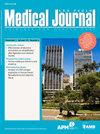A467T variant of the polg gene: description of two clinical cases
IF 1.3
4区 医学
Q2 MEDICINE, GENERAL & INTERNAL
引用次数: 0
Abstract
Introduction: Variations in the POLG gene are the most common causes of mitochondrial disease of autosomal inheritance, and may be present in about 2% of the population. Case report: Case 1. CMAM, male, 48-year-old, complaining of bilateral eyelid ptosis with onset in adolescence. Since the age of six, he has been diagnosed with epilepsy. After five years of follow-up, he developed sensory ataxia. After 10 years he began to present dysarthria, dysphagia, tremor and pyramidal syndrome. Case 2. ASB, female, 42 years old, at 20 years old presented generalized clonic tonic crisis during the second and third trimesters of pregnancy; at 35 years of age she complained of tingling in plants and legs; at 37 years she noticed bilateral eyelid ptosis and at 39 years she noticed the presence of slurred speech and fatigue on small efforts. He has 3 siblings with similar symptoms and great difficulty walking. No history of consanguinity. Propedeutics: Normal serum lactate and CPK dosage; muscle biopsy showed variation in the caliber of muscle fibers, with the presence of “ragged red fibers” in Gomori’s Trichrome stain. Cranial magnetic resonance imaging: mild cerebellar atrophy in patient 1 and normal in patient 2. Electroneuromyography reveled absence of sensory action potentials in all nerves studied in both cases. New generation sequencing myopathy panel revealed pathogenic variant in homozygosis in the POLG c.1399G>A gene (p.Ala467Thr). Results: The patients received the diagnosis of mitochondrial disease, presenting complex clinical phenotype. Conclusion: DNA polymerase gamma is the enzyme responsible for replicating and maintaining mitochondrial DNA, encoded by nuclear DNA. The c.1399G>A variant in exon7 causes a replacement of an alanine with threonine (A467T), and is one of the causes of ataxia, such as spinocerebellar ataxia with epilepsy; autosomal recessive mitochondrial ataxia, sensory neuropathy, dysarthria and ophthalmoparesis and myoclonic epilepsy, myopathy and sensory ataxia. However, most of the time, they present a continuum between the phenotypes described.polg基因的A467T变异:两例临床病例的描述
简介:POLG基因变异是常染色体遗传的线粒体疾病最常见的原因,可能存在于约2%的人群中。病例报告:病例1。CMAM,男,48岁,主诉双侧眼睑下垂,青春期发病。从六岁起,他就被诊断患有癫痫。5年后,他出现了感觉性共济失调。10年后,他开始出现构音障碍、吞咽困难、震颤和锥体综合征。例2。ASB,女,42岁,20岁时在妊娠中晚期出现全身性阵挛性强直危象;35岁时,她抱怨植物和腿部有刺痛感;37岁时,她注意到双侧眼睑下垂,39岁时,她注意到言语不清和轻微的疲劳。他有3个兄弟姐妹也有类似的症状,而且行走非常困难。没有血缘史。预后:血清乳酸、CPK剂量正常;肌肉活检显示肌纤维直径的变化,在Gomori三色染色中存在“粗糙的红色纤维”。颅脑磁共振成像:患者1轻度小脑萎缩,患者2正常。两例患者的神经肌电图均显示感觉动作电位缺失。新一代测序肌病面板显示POLG c.1399G>A基因纯合子的致病变异(p.a ala467thr)。结果:本组患者均诊断为线粒体疾病,临床表现复杂。结论:DNA聚合酶γ是由核DNA编码的负责线粒体DNA复制和维持的酶。外显子7中的c.1399G>A变异导致丙氨酸被苏氨酸取代(A467T),是共济失调的原因之一,如脊髓小脑性共济失调伴癫痫;常染色体隐性线粒体共济失调,感觉神经病变,构音障碍和眼麻痹,肌阵挛性癫痫,肌病和感觉共济失调。然而,大多数时候,它们在所描述的表型之间呈现连续统一体。
本文章由计算机程序翻译,如有差异,请以英文原文为准。
求助全文
约1分钟内获得全文
求助全文
来源期刊

Sao Paulo Medical Journal
医学-医学:内科
CiteScore
2.20
自引率
7.10%
发文量
210
审稿时长
6-12 weeks
期刊介绍:
Published bimonthly by the Associação Paulista de Medicina, the journal accepts articles in the fields of clinical health science (internal medicine, gynecology and obstetrics, mental health, surgery, pediatrics and public health). Articles will be accepted in the form of original articles (clinical trials, cohort, case-control, prevalence, incidence, accuracy and cost-effectiveness studies and systematic reviews with or without meta-analysis), narrative reviews of the literature, case reports, short communications and letters to the editor. Papers with a commercial objective will not be accepted.
 求助内容:
求助内容: 应助结果提醒方式:
应助结果提醒方式:


